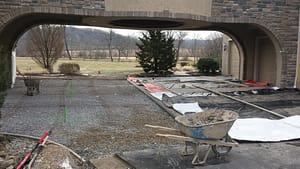

The following is an interesting blog by By Brian Adams, PCM Concrete Division Manager that describes how concrete will cure properly in cold weather if the right precautions are made.
Pouring Concrete in Cold Weather
Many people don’t realize concrete can be poured throughout the winter. Sure, there are some added challenges when it comes to pouring concrete in colder temperatures, but we find that when taking a few extra precautions, concrete installed in the winter works just as well as concrete installed any other time of the year. So, rest easy, it’s not too late to fix that trip hazard after all.
So, how does it work?
For concrete to set properly and harden, a chemical reaction called “hydration” (also known as the curing process) must take place. To put it simply, the hydration process is when the chemicals in the concrete react with water to bind the mixture together. Curing is one of the most important steps in concrete construction. Proper curing greatly increases concrete strength and durability.
Concrete sets much slower in cold weather. In order for hydration to occur, the temperature of the concrete must be ≥ 40ºF. Anything below this will slow the hydration process, and may even stop it altogether. It is critical that the concrete sets before it is exposed to freezing temperatures. The problem is when all of the water freezes; it expands, causing your concrete to crack. The key is to do what you can to make sure the concrete sets fast enough to prevent this freeze-thaw disaster.
In the case of placing concrete, when we say “cold weather” we are referring to a period of time when the average daily temperature falls below 40ºF for more than three consecutive days. These conditions call for special provisions when placing, curing, and protecting concrete against the effects of cold weather. In its plastic state (as a malleable liquid), concrete will freeze if its temperature falls below 25ºF. If plastic concrete freezes, its potential strength can be reduced by more than 50% and its durability will suffer accordingly. Concrete should be protected from freezing until it reaches a minimum compressive strength of 500 psi, which is equivalent to about two days after placement for most concrete maintained at 50ºF.
To get your site ready to pour the concrete, make sure you have all of the appropriate insulation and heating equipment on hand. The ground must be thawed prior to placing any concrete. Concrete shouldn’t be poured on frozen subgrade. It just won’t work. If concrete is placed on frozen subgrade, uneven settling will occur when the subgrades unthaws, resulting in cracking. The temperature of the subgrade should be as close to the temperature of concrete being poured. If the depth of the frozen subgrade is only a few inches, there are a number of thawing options, such as spreading hot sand or gravel, steaming, or covering it with insulation for a few days.
Keeping the dry product in a heated area until you are ready to use it is a great start. But in most cases additional measures will need to be taken. You could…
As concrete cures it emits heat. This is why covering concrete with a curing blanket during the hydration period is one of the easiest ways to hold in heat and thus cure the concrete faster in colder temperatures. If you choose to add hot water, we recommend you maintain a consistent water temperature in each batch of concrete to guarantee equal performance. If you choose to use additives, we encourage you to pay attention to the type of accelerator. If the additive contains calcium chloride and your concrete contains rebar or metal wire mesh, the chlorides will corrode the steel or metal and crack your beautiful, new concrete.

Covering the recently poured concrete in curing blankets – Smith Project January 2015 – Signature Concrete Design
Give us a call at 610.923.5073, contact us or stop into our Easton showroom to see what we can create for you.
Contact Us Today View Service Area